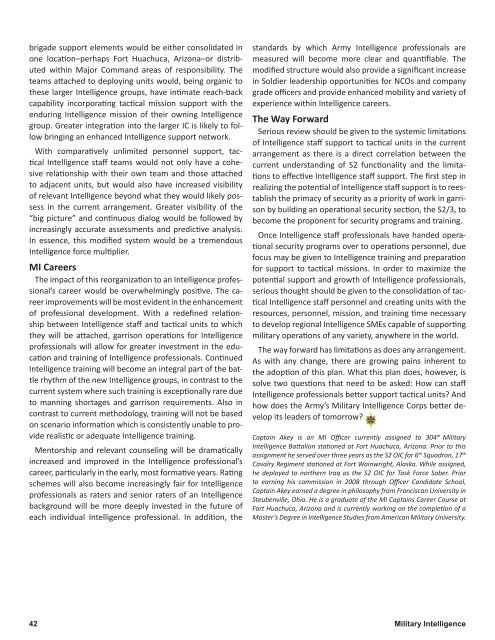2014_01
2014_01
2014_01
You also want an ePaper? Increase the reach of your titles
YUMPU automatically turns print PDFs into web optimized ePapers that Google loves.
igade support elements would be either consolidated inone location–perhaps Fort Huachuca, Arizona–or distributedwithin Major Command areas of responsibility. Theteams attached to deploying units would, being organic tothese larger Intelligence groups, have intimate reach-backcapability incorporating tactical mission support with theenduring Intelligence mission of their owning Intelligencegroup. Greater integration into the larger IC is likely to followbringing an enhanced Intelligence support network.With comparatively unlimited personnel support, tacticalIntelligence staff teams would not only have a cohesiverelationship with their own team and those attachedto adjacent units, but would also have increased visibilityof relevant Intelligence beyond what they would likely possessin the current arrangement. Greater visibility of the“big picture” and continuous dialog would be followed byincreasingly accurate assessments and predictive analysis.In essence, this modified system would be a tremendousIntelligence force multiplier.MI CareersThe impact of this reorganization to an Intelligence professional’scareer would be overwhelmingly positive. The careerimprovements will be most evident in the enhancementof professional development. With a redefined relationshipbetween Intelligence staff and tactical units to whichthey will be attached, garrison operations for Intelligenceprofessionals will allow for greater investment in the educationand training of Intelligence professionals. ContinuedIntelligence training will become an integral part of the battlerhythm of the new Intelligence groups, in contrast to thecurrent system where such training is exceptionally rare dueto manning shortages and garrison requirements. Also incontrast to current methodology, training will not be basedon scenario information which is consistently unable to providerealistic or adequate Intelligence training.Mentorship and relevant counseling will be dramaticallyincreased and improved in the Intelligence professional’scareer, particularly in the early, most formative years. Ratingschemes will also become increasingly fair for Intelligenceprofessionals as raters and senior raters of an Intelligencebackground will be more deeply invested in the future ofeach individual Intelligence professional. In addition, thestandards by which Army Intelligence professionals aremeasured will become more clear and quantifiable. Themodified structure would also provide a significant increasein Soldier leadership opportunities for NCOs and companygrade officers and provide enhanced mobility and variety ofexperience within Intelligence careers.The Way ForwardSerious review should be given to the systemic limitationsof Intelligence staff support to tactical units in the currentarrangement as there is a direct correlation between thecurrent understanding of S2 functionality and the limitationsto effective Intelligence staff support. The first step inrealizing the potential of Intelligence staff support is to reestablishthe primacy of security as a priority of work in garrisonby building an operational security section, the S2/3, tobecome the proponent for security programs and training.Once Intelligence staff professionals have handed operationalsecurity programs over to operations personnel, duefocus may be given to Intelligence training and preparationfor support to tactical missions. In order to maximize thepotential support and growth of Intelligence professionals,serious thought should be given to the consolidation of tacticalIntelligence staff personnel and creating units with theresources, personnel, mission, and training time necessaryto develop regional Intelligence SMEs capable of supportingmilitary operations of any variety, anywhere in the world.The way forward has limitations as does any arrangement.As with any change, there are growing pains inherent tothe adoption of this plan. What this plan does, however, issolve two questions that need to be asked: How can staffIntelligence professionals better support tactical units? Andhow does the Army’s Military Intelligence Corps better developits leaders of tomorrow?Captain Akey is an MI Officer currently assigned to 304 th MilitaryIntelligence Battalion stationed at Fort Huachuca, Arizona. Prior to thisassignment he served over three years as the S2 OIC for 6 th Squadron, 17 thCavalry Regiment stationed at Fort Wainwright, Alaska. While assigned,he deployed to northern Iraq as the S2 OIC for Task Force Saber. Priorto earning his commission in 2008 through Officer Candidate School,Captain Akey earned a degree in philosophy from Franciscan University inSteubenville, Ohio. He is a graduate of the MI Captains Career Course atFort Huachuca, Arizona and is currently working on the completion of aMaster’s Degree in Intelligence Studies from American Military University.42 Military Intelligence


